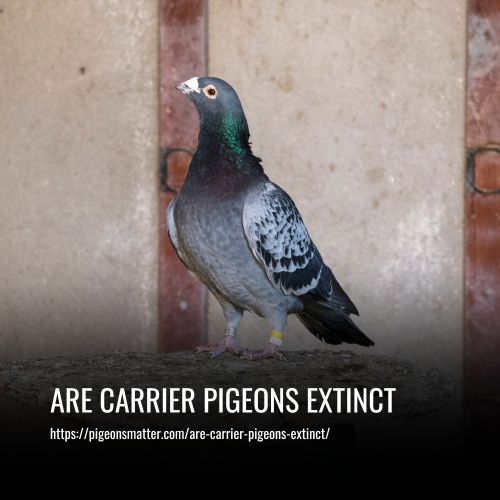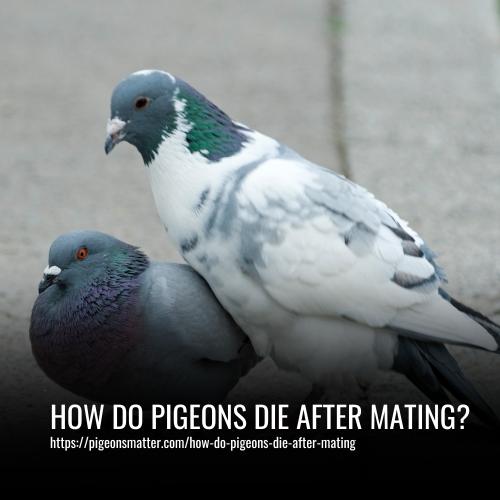The carrier pigeon, also known as the passenger pigeon, is now extinct. The last known living carrier pigeon was a captive bird named Martha, who passed away in 1914 at the Cincinnati Zoo. Sadly, natural populations of carrier pigeons had already disappeared by that time. Martha was 29 years old when she died and was unable to lay a viable egg.
The last recorded shooting of a carrier pigeon was in 1900, after which the bird was mounted. The shooter was unaware of the species he had killed.

Martha, the Last Passenger Pigeon
Martha, a Passenger Pigeon, was a beloved attraction at the Cincinnati Zoo. Unfortunately, she passed away on September 1, 1914, and was believed to be the last of her species after her two male companions had died in the same zoo in 1910. Her death marked the end of an era, in which the Passenger Pigeon had once been the most abundant bird species in North America.
After Martha’s death, her body was preserved as a taxidermy mount and anatomical specimen at the Smithsonian Institution in Washington, DC. The specimen is now on public display in the museum’s Objects of Wonder exhibit and is considered one of the institution’s most prized possessions. The extinction of the Passenger Pigeon played a significant role in shaping our modern conservation efforts.
The Passenger Pigeon
The passenger pigeon was once a thriving bird species in the United States, with an estimated population of 3 to 5 billion birds at the time of European arrival. They were known for their impressive flight capabilities and graceful appearance, with males averaging about 16.5 inches in length and having a bluish-gray head and upper body with black streaks and iridescent patches on the neck.
Their habitat was mixed hardwood forests, where they found their spring nesting sites, winter “roosts,” and food. They relied on large forests for their survival due to their communal habit and need for nesting and roosting sites. However, as settlers cleared the eastern forests for farmland, the birds were forced to shift to the remaining forests and began utilizing farmers’ grain fields when their food supply decreased. This led to conflict with farmers who began shooting them for meat.
Despite this, the total number of birds was not significantly diminished until professional hunters began netting and shooting them for sale in city markets in the 1800s. The lack of laws restricting the number of pigeons killed or the method of hunting led to the widespread slaughter of hundreds of thousands of pigeons. By the early 1890s, the passenger pigeon had almost completely disappeared, and efforts to protect them through legislation were too late. The extinction of the passenger pigeon was a result of the clash between their need for large forests and human civilization’s interest in clearing forests for farmland.
Why Did The Passenger Pigeon Go Extinct?
The extinction of the passenger pigeon is a remarkable event in human history. Despite being hunted by humans, the rapid extinction decline of the species from billions to none within just fifty years is still a mystery. Scientists are exploring the genetic factors that may have contributed to this decline.
The question remains: how could a species with such a vast and widespread population disappear so quickly? Did humans really kill every last one of them? Why didn’t any pigeons survive in remote areas? These are some of the questions that researchers are still trying to answer.
The Mystery Deepens
Despite being one of the most populous bird species on the planet, the passenger pigeon was driven to extinction, leaving scientists to wonder how such an abundant species could disappear. A 2014 study found that passenger pigeons had less genetic diversity than expected, suggesting that their periodic population crashes created genetic bottlenecks that reduced genetic diversity.
However, a new study challenges this conclusion after sequencing and analyzing passenger pigeon genomes. The researchers found that while the passenger pigeon genome had surprisingly low diversity, some regions of the genome had very low diversity, while others did not.
Additionally, the genetic diversity in the mitochondrial genome did not correspond with the genomic data, indicating that their population had been stable for the past 20,000 years. These findings deepen the mystery surrounding the extinction of the passenger pigeon.
Curiouser And Curiouser
The passenger pigeon, Ectopistes migratorius, was a fascinating bird that lived in large colonies throughout the eastern United States. With their sleek and slender bodies, they were built for speed and could travel long distances freely. Interestingly, their genome did not show any geographic structure, which is typically seen in more sedentary species.
While it was believed that their population underwent periodic fluctuations that reduced their genetic diversity, there is another possible explanation: natural selection. The concept of the “hitch-hiking effect” suggests that a selected gene can affect the fate of other genes in its genomic neighborhood.
To investigate this further, researchers compared the genetic diversity of the passenger pigeon to that of the band-tailed pigeon, Patagioenas fasciata.
Is A Return Possible?
The possibility of bringing back the passenger pigeon through de-extinction has been a topic of discussion among scientists. While the bird survived at small population sizes during periods of ice, it is uncertain whether creating billions of them is necessary for sustainable populations. The Long Now Foundation’s Revive & Restore project, led by Ben Novak in conjunction with Shapiro’s lab, aims to bring back the passenger pigeon through de-extinction. Novak predicts that the passenger pigeon of the future will adapt to modern forests, unlike its evolutionary past where it was constrained by supplies of acorns and another mast.
However, the de-extinction of the passenger pigeon poses social and genetic challenges, and some experts do not believe it is a worthy step to take for conservation. The return of the great eastern forest is also necessary for genetic resurrection to work. Moreover, the possibility of the bird becoming a pest and destroying crops raises concerns about its reintroduction. Despite these challenges, the genetic information from museum specimens provides hope for future research on extinct and living species.
How Did the Carrier Pigeon (Passenger Pigeon) Go Extinct?
The carrier pigeon, also known as the passenger pigeon, went extinct due to a combination of overhunting and deforestation. Although subsistence hunting had taken place for many years, the commercialization of pigeon meat ultimately led to their downfall. The opening of transcontinental railroads made it easy to transport hunters and their products, leading to the relentless hunting of passenger pigeons.
Farmers also hunted them to protect their crops. Despite becoming harder to find, hunters continued to pursue them until they were completely gone. Passenger pigeons were not able to adapt fast enough to the mass murder event, as their survival adaptation was to outnumber predators and overwhelm them.
Their social behavior, nesting together in large groups, made them easy targets. Deforestation was the final blow that drove them to extinction. Some scientists have argued that the passenger pigeon was already in decline before hunting began, but genetic evidence suggests that they were a thriving population.
What Did the Passenger Pigeon (Carrier Pigeon) Eat?
The passenger pigeon, also known as the carrier pigeon, had a varied diet. They enjoyed eating tree nuts such as beechnuts and acorns, as well as seasonal berries like grapes, pokeberries, and blueberries. In the breeding range season, they consume invertebrates like caterpillars and worms.
Unfortunately, their appetite for crops like buckwheat and corn caused them to be viewed as pests by farmers, leading to hunting and a decline in their population. However, the passenger pigeon was able to adapt to less desirable food sources like farmed corn as forests disappeared, proving that food scarcity was not the sole reason for their extinction.
Did the Carrier Pigeon Carry Anything?
Although the North American passenger pigeon did not carry anything, there are pigeons known as “carrier pigeons” that have been used to deliver messages for centuries. The ancient Persians were the first to use them, followed by the Greeks and Romans. Europeans used them extensively until the invention of the telegraph.
During wartime, carrier pigeons were used extensively. Carrier pigeons, now known as homing pigeons, have a well-known reputation for their capacity to return to their owners’ nests. They have been utilized for message and object delivery for many centuries.
Although homing pigeons were previously utilized by the USPS, the advancement of the telegraph and railroad led to the discontinuation of this service. The ownership and operation of homing pigeon messaging services remain in the hands of private individuals.
Why Are They Called Passenger (Carrier) Pigeons in North America?
The North American Passenger Pigeon is named as such because of the French word “passager,” which means to pass. This refers to the huge flocks of pigeons that would pass over humans during their migrations, giving them the name “passenger pigeons.”
While homing pigeons are domesticated and used for carrying things, passenger pigeons were wild pigeons and not used for this purpose. The North American Passenger Pigeon was occasionally called a carrier pigeon due to its species classification as a pigeon.
Did Pigeons Serve in the Navy?
Believe it or not, pigeons played a role in the Navy. They were utilized as early as the 1880s and as late as WWII. Their primary purpose was to relay messages to the Navy before telegraphs were available on all ships.
Homing pigeons were responsible for delivering crucial information from ships to the mainland. The use of pigeons in certain situations proved to be advantageous, as they delivered crucial messages that had the potential to save lives.
The Navy stopped using pigeons around 1902. Pigeons were once outfitted with a Maidenform chest pocket for message transportation, which is noteworthy. It’s amazing to think about the unique ways amazing animals have contributed to our history!
Do Drug Smugglers Use Carrier Pigeons?
Drug smugglers have found a creative way to transport illicit substances – by using carrier pigeons. Although the North American passenger pigeon is extinct, other species of pigeons are being used to smuggle drugs in various parts of the world. Some of these birds have been discovered at border crossings or leaving jails, and law enforcement agencies have intercepted some of them alive while others have been shot down. Unfortunately, it’s difficult to determine the exact number of drug-smuggling pigeons in existence today.
FAQs
No, carrier pigeons are not extinct. While their widespread use has diminished significantly with the advent of modern communication technologies, pigeons themselves still exist, and some enthusiasts continue to keep and train them for various purposes.
Carrier pigeons were historically used as messengers, delivering important messages across long distances. They played a crucial role in military communication, particularly during wartime, where they demonstrated remarkable speed and reliability.
While their use as messengers has declined significantly due to technological advancements, some hobbyists and pigeon enthusiasts still train carrier pigeons for sport, racing, and exhibition purposes. However, their role in practical communication has been largely replaced by modern means.
Carrier pigeons are capable of reaching speeds of up to 60 miles per hour (97 kilometers per hour) and can cover distances of several hundred miles in a single flight. Their impressive speed and homing abilities made them valuable messengers throughout history.
Carrier pigeons possess a remarkable homing instinct, allowing them to find their way back to their home loft over vast distances. The exact mechanism behind this ability is not fully understood, but it is believed to involve a combination of visual, magnetic, and olfactory cues.
Carrier pigeons are not migratory birds. Unlike many bird species that migrate seasonally, carrier pigeons are known for their strong homing instincts, always returning to their designated loft. This characteristic made them particularly valuable as reliable messengers throughout history.
Conclusion:
While carrier pigeons may not be as common as they once were, they are not extinct. These birds have played an important role in human history and continue to be used in some parts of the world today.
However, their decline in numbers serves as a reminder of the importance of conservation efforts and the impact that humans can have on the natural world.
By taking steps to protect and preserve species like carrier pigeons, we can ensure that they will continue to be a part of our world for generations to come.


